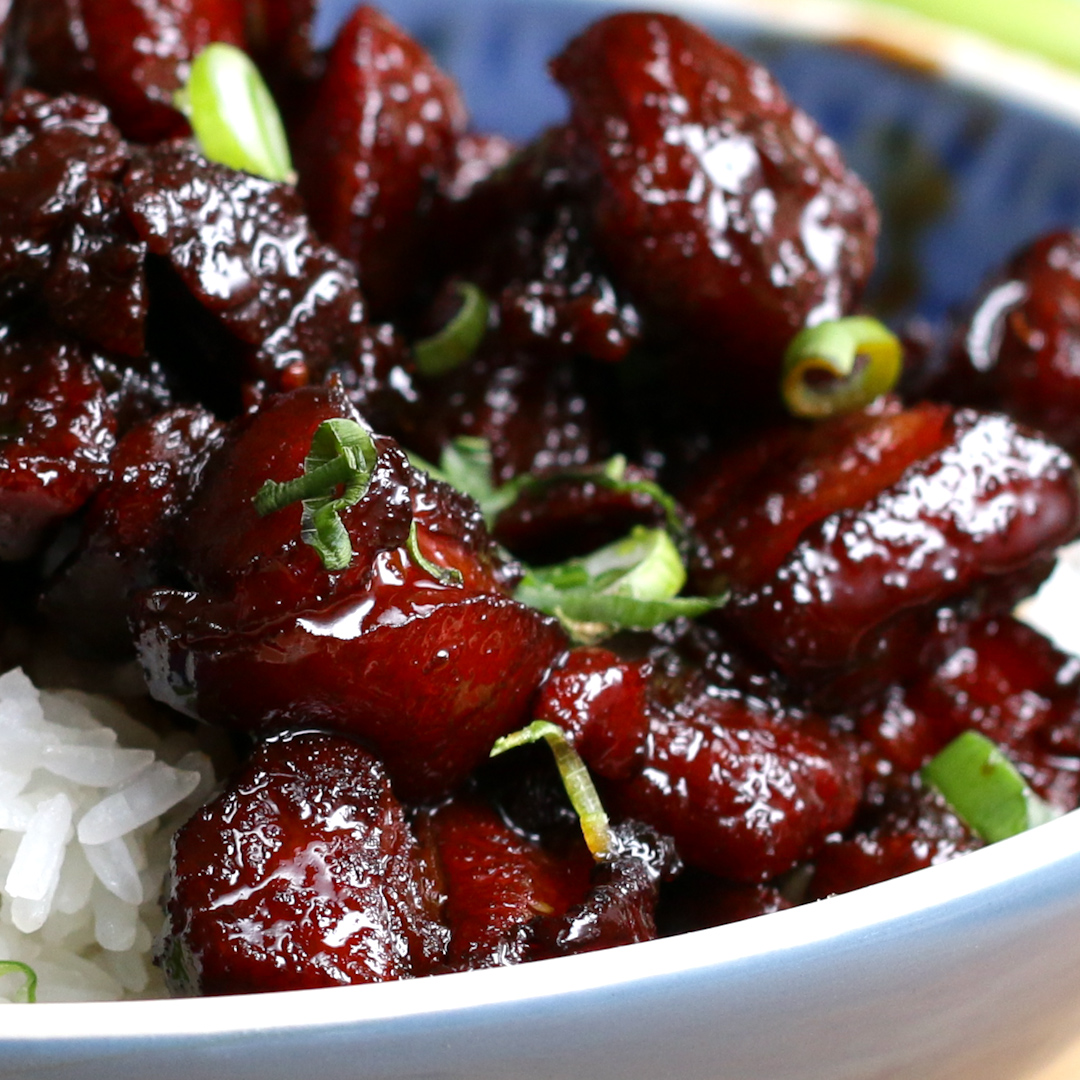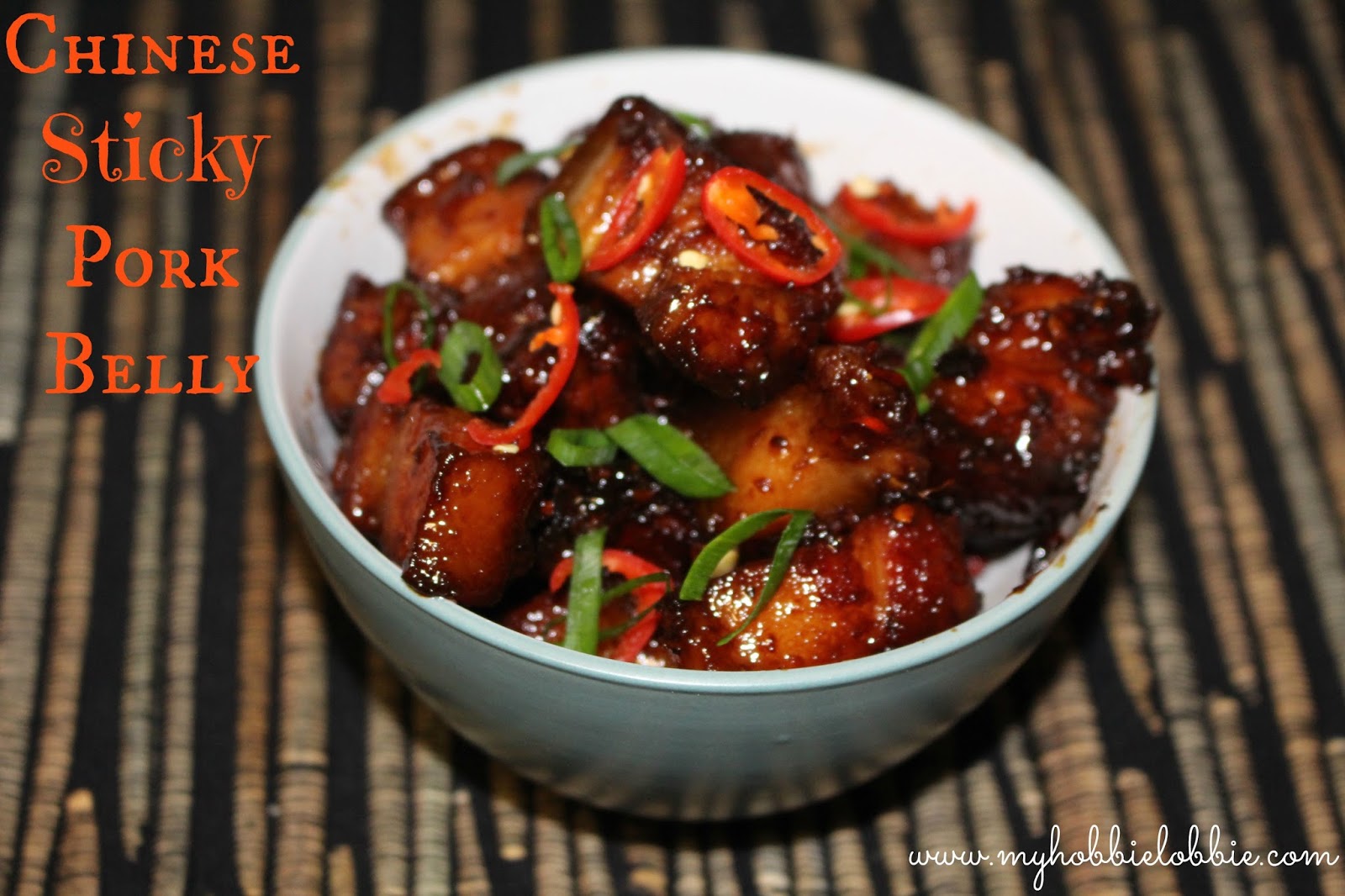Embark on a gastronomic adventure as we delve into the captivating world of Chinese sticky pork belly. This beloved dish, with its tantalizing flavors and succulent texture, has captivated palates for centuries, transcending regional boundaries and cultural traditions.
In this comprehensive guide, we will uncover the secrets of crafting the perfect Chinese sticky pork belly. From selecting the finest ingredients to mastering the art of marinating, cooking, and saucing, we will guide you through every step of this culinary masterpiece.
Chinese Sticky Pork Belly Ingredients
Chinese sticky pork belly is a popular dish known for its tender, flavorful meat and crispy, caramelized skin. The key to achieving the perfect sticky pork belly lies in the ingredients used and the cooking technique. Here’s a detailed list of ingredients commonly used in Chinese sticky pork belly recipes:
- Pork belly: This is the main ingredient of the dish. Choose pork belly with a good balance of meat and fat for optimal flavor and texture.
- Five-spice powder: This aromatic spice blend typically includes cinnamon, cloves, fennel, star anise, and Szechuan peppercorns. It adds warmth and depth of flavor to the pork.
- Soy sauce: Soy sauce provides a salty and umami flavor to the pork. It also helps to tenderize the meat.
- Shaoxing wine: This Chinese rice wine adds a subtle sweetness and complexity to the dish. It also helps to remove any porky smell.
- Hoisin sauce: Hoisin sauce is a thick, sweet, and savory sauce made from fermented soybeans. It adds a rich, umami flavor to the pork.
- Honey: Honey provides sweetness and helps to caramelize the pork skin, giving it a crispy and golden-brown appearance.
- Ginger and garlic: Ginger and garlic are aromatic ingredients that add depth of flavor and help to balance the sweetness of the other ingredients.
These ingredients, when combined and cooked together, create a harmonious balance of flavors and textures that make Chinese sticky pork belly a delectable dish.
Pork Belly Selection and Preparation
Selecting and preparing the right pork belly is crucial for a tender and flavorful Chinese sticky pork belly. Here’s a guide to help you choose and prepare the perfect pork belly:
Pork Belly Selection
When selecting pork belly, look for a piece with a good balance of meat and fat. The skin should be firm and have a slight bounce when pressed. Avoid pork belly with excessive fat or thin skin, as these can affect the final texture and flavor.
Pork Belly Preparation
Once you have selected a suitable pork belly, prepare it for cooking by trimming and scoring. Start by trimming any excess fat or silver skin from the surface. Then, score the skin deeply using a sharp knife, making sure to cut through the fat but not into the meat.
Scoring the skin allows the fat to render out and the skin to crisp up during cooking.
Marinade Creation and Application
The marinade is the heart of the Chinese Sticky Pork Belly, providing it with its characteristic sweet, savory, and slightly tangy flavor. Traditionally, it consists of a blend of soy sauce, rice wine, hoisin sauce, honey, garlic, ginger, and five-spice powder.
To create the marinade, combine all the ingredients in a bowl and whisk until well blended. The soy sauce and rice wine provide a salty and umami base, while the hoisin sauce adds a rich, savory sweetness. Honey contributes a touch of sweetness and a golden-brown glaze when roasted.
Garlic and ginger infuse the pork with aromatic flavors, and the five-spice powder adds a warm, complex blend of spices.
Applying the Marinade
Once the marinade is ready, apply it generously to the pork belly. Using a pastry brush or your hands, work the marinade into the crevices of the meat, ensuring it is evenly coated. Allow the pork to marinate in the refrigerator for at least 4 hours, or preferably overnight, to allow the flavors to fully penetrate the meat.
Cooking Methods
Chinese sticky pork belly can be cooked using various methods, each imparting a unique flavor and texture to the dish. Let’s explore the most common techniques and their respective advantages and disadvantages.
Braising
Braising involves slowly cooking the pork belly in a flavorful liquid, typically a combination of soy sauce, rice wine, and aromatics. This method results in tender and succulent meat with a rich and savory flavor. Advantages of braising include even cooking, enhanced flavor absorption, and the ability to control the cooking time to achieve desired tenderness.
Roasting
Roasting involves cooking the pork belly in an oven. This method allows for a crispy exterior while maintaining a moist and flavorful interior. The advantage of roasting is the development of a caramelized and flavorful skin. However, it requires careful monitoring to prevent overcooking or drying out.
Deep-Frying
Deep-frying is a technique where the pork belly is submerged in hot oil. This results in a crispy and golden-brown exterior with a tender and juicy interior. Advantages of deep-frying include rapid cooking time and the ability to achieve a uniform crispiness.
However, it is important to control the oil temperature to prevent burning or undercooking.
Sauce Preparation
The sticky sauce is the crowning glory of Chinese pork belly, and its preparation is a delicate art. The sauce is typically made with a combination of soy sauce, honey, rice vinegar, and spices. The ingredients are first combined in a saucepan and brought to a boil.
The heat is then reduced, and the sauce is simmered until it has thickened and reduced by about half.
Sugar Caramelization
One of the key steps in making the sticky sauce is caramelizing the sugar. This process gives the sauce its characteristic brown color and rich flavor. To caramelize the sugar, it is first sprinkled into the saucepan and allowed to melt.
The heat is then increased, and the sugar is stirred constantly until it has turned a deep amber color.
Presentation and Serving Suggestions
To showcase the tantalizing flavors and textures of Chinese sticky pork belly, presentation plays a crucial role. Here are some ideas to elevate the visual appeal of this delectable dish:
Consider arranging the pork belly slices on a large platter or serving board. Drizzle the remaining sauce over the meat to enhance its glossy sheen. For a vibrant touch, garnish with thinly sliced scallions, cilantro leaves, or a sprinkling of sesame seeds.
Traditional Accompaniments
Traditionally, Chinese sticky pork belly is paired with specific accompaniments that enhance its overall dining experience:
- Steamed Rice: The soft and fluffy texture of steamed rice provides a perfect base for soaking up the flavorful sauce and succulent pork.
- Stir-Fried Vegetables: A medley of stir-fried vegetables, such as bok choy, broccoli, or carrots, adds a vibrant color and freshness to the meal.
- Eggplant with Garlic Sauce: The smoky flavor of eggplant paired with the savory garlic sauce creates a harmonious balance of flavors.
- Homemade Pickles: A selection of homemade pickles, such as cucumbers or radishes, offers a tangy and refreshing contrast to the richness of the pork belly.
Variations and Regional Differences

Chinese sticky pork belly recipes exhibit regional variations, each boasting unique ingredients and cooking methods that reflect the culinary heritage of different provinces.
One notable variation is the use of different sauces. In the northern region, sticky pork belly is often glazed with a sweet and tangy hoisin sauce, while in the southern region, it is typically coated in a savory soy sauce-based glaze.
The resulting flavors range from subtly sweet to intensely umami.
Sichuan Sticky Pork Belly
Sichuan cuisine is renowned for its bold flavors, and its sticky pork belly is no exception. This variation incorporates the use of Sichuan peppercorns, chili oil, and fermented black beans, resulting in a dish that is both spicy and aromatic.
Cantonese Sticky Pork Belly
Cantonese cuisine is known for its emphasis on balance and harmony. The Cantonese sticky pork belly is characterized by a delicate balance of sweet and savory flavors, achieved through the use of a combination of honey, soy sauce, and rice wine.
Nutritional Information and Health Considerations

Chinese sticky pork belly is a flavorful dish, but it’s important to consider its nutritional content and potential health implications before indulging.
This dish is high in calories, fat, and sodium. A single serving can contain over 500 calories, 30 grams of fat, and 1,000 milligrams of sodium. Excessive consumption can contribute to weight gain, high blood pressure, and other health issues.
Health Considerations
- High in saturated fat: Pork belly is a fatty cut of meat, and the cooking process further increases the saturated fat content. Saturated fat can raise LDL cholesterol levels, which can increase the risk of heart disease.
- High in sodium: The marinade and sauce used to prepare sticky pork belly typically contain high amounts of sodium. Excessive sodium intake can lead to fluid retention, high blood pressure, and other health problems.
- Potential for foodborne illness: Pork belly must be cooked thoroughly to prevent the risk of foodborne illnesses such as trichinosis and salmonella.
It’s recommended to consume Chinese sticky pork belly in moderation as part of a balanced diet. Individuals with certain health conditions, such as heart disease or high blood pressure, should exercise caution when consuming this dish.
Last Recap
As you savor the delectable flavors of your homemade Chinese sticky pork belly, remember that it is not merely a dish but a testament to the culinary artistry of a vibrant culture. Its tantalizing aroma, crispy skin, and melt-in-your-mouth texture will undoubtedly leave you craving for more.
So, gather your ingredients, prepare your palate, and embark on this culinary journey to create a dish that will delight your senses and transport you to the heart of Chinese culinary traditions.
FAQs
Can I use a different cut of pork for this recipe?
While pork belly is the traditional cut used in this recipe, you can substitute it with pork shoulder or pork loin. However, these cuts may require adjustments in cooking time and may not yield the same crispy skin as pork belly.
How can I make the sauce thicker?
To thicken the sauce, you can simmer it for a longer period of time, allowing the liquid to reduce and concentrate. Alternatively, you can add a cornstarch slurry (equal parts cornstarch and water) to the sauce and cook until thickened.
Can I cook the pork belly ahead of time?
Yes, you can cook the pork belly up to 2 days ahead of time. Allow it to cool completely, then store it in an airtight container in the refrigerator. When ready to serve, reheat the pork belly in a preheated oven at 350°F (175°C) until warmed through.
